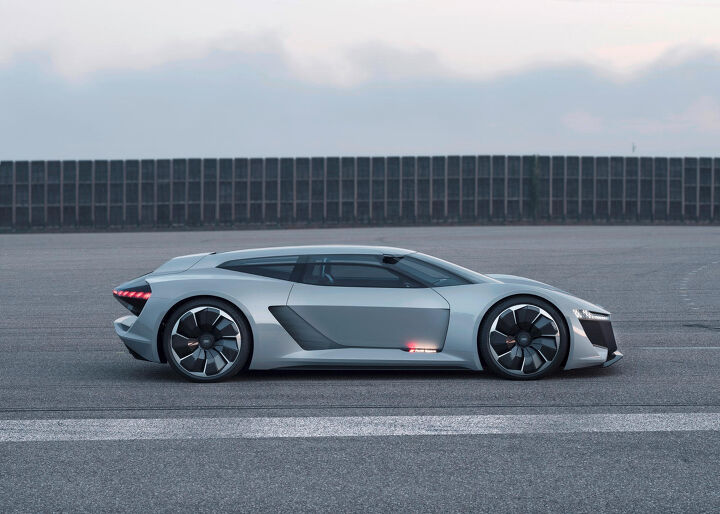Electrified in Monterey: Audi's PB 18 E-tron Concept Is Phenomenal

Concept vehicles have been a bit of a snoozefest for enthusiasts lately. Despite the fact that automakers are still plenty capable of bringing out gorgeous designs, the autonomous angle has become so pervasive that it’s overridden the idea of having fun.
Then, during this week’s Monterey Car Week festivities, Audi dropped the PB 18 e-tron concept at Laguna Seca and fun slapped us across the face. This is the kind of car you have on your bedroom wall as a child and work your entire life to put into a garage as an adult.
With three electric motors (one driving the front axle and two out back) providing a combined output of 671 horsepower and 612 lb-ft of torque, the PB 18 should already be a menace. However, it can also temporarily bump itself up to 764 hp using stored energy via a kinetic energy recovery system. As a result, Audi claims the car is capable of a 0-to-62 mph rush in just over 2 seconds.
Combine that with an ultra-modern design that’s within the boundaries of what’s currently possible and several scoops of driver-focused tech, and you have one of best concept vehicles we’ve seen in years. The PB 18 expertly rides the line between fanciful and plausible.
While the emphasis here is definitely on performance, the model even has an electronically adjustable cockpit that slides the driver over into a central position and stows the passenger seat. Still, Audi has not ignored practicality. While the manufacturer didn’t cite cargo capacity, the shooting brake design is a little more practical than something with a pinched tail. It would also be slipshod of us to not comment on how much we like the look of it.
Digitally detuned for cruising, the e-tron is said to be capable of 310 miles on a single charge using European metrics. Its regenerative braking system doesn’t even come into play until a hard stop is required. The rest of the time the trio of electric motors are solely responsible for slowing the car down, which dumps significant amounts energy back into the 95-kWh battery.
Those motors being separate entities have also allowed Audi to implement a torque control manager to enhance the car’s handling in extreme situations — whether environmental or driver induced. Working in tandem with the stability control computer, the management system actively distributes the power to whatever wheel is in the most need at any given moment. In higher-speed scenarios, handling is further improved by a mechanically adjustable rear diffuser and spoiler.
Getting its name from the R18 e-tron Quattro racing car, the PB 18 shares its (optional) central driving position, massive wheel arches, and some high-tech hardware — like the suspension. The rest of the design is pure Blade Runner with a dash of R8 for good measure. We’re hoping it’s a subtle hint that this styling could serve as the model’s eventual replacement.
Audi it has no plans to build the model, however. Disappointing, sure, but we understand that it may be a little too ambitious for the general market. Composed entirely of aluminum, carbon, and various multi-material composites to ensure lightness, the PB 18 e-tron is said to weigh less than 3,417 pounds. As stellar as that sounds, when you combine those high-cost materials with a large solid-state battery, cutting-edge race suspension, three electric motors, advanced 800-volt charging capabilities, and tons of electronic trickery, you’ll probably end up with an astronomical MSRP.
We’re still glad the Germans tossed this piece of magnificence together. It makes one feel excited about the future, especially as it relates to electric vehicles. Even if the PB 18 is a pipe dream, it still delivers hope. We’d be happy to see any aspect of it appearing in subsequent Audi models.
[Images: Audi]

A staunch consumer advocate tracking industry trends and regulation. Before joining TTAC, Matt spent a decade working for marketing and research firms based in NYC. Clients included several of the world’s largest automakers, global tire brands, and aftermarket part suppliers. Dissatisfied with the corporate world and resentful of having to wear suits everyday, he pivoted to writing about cars. Since then, that man has become an ardent supporter of the right-to-repair movement, been interviewed on the auto industry by national radio broadcasts, driven more rental cars than anyone ever should, participated in amateur rallying events, and received the requisite minimum training as sanctioned by the SCCA. Handy with a wrench, Matt grew up surrounded by Detroit auto workers and managed to get a pizza delivery job before he was legally eligible. He later found himself driving box trucks through Manhattan, guaranteeing future sympathy for actual truckers. He continues to conduct research pertaining to the automotive sector as an independent contractor and has since moved back to his native Michigan, closer to where the cars are born. A contrarian, Matt claims to prefer understeer — stating that front and all-wheel drive vehicles cater best to his driving style.
More by Matt Posky
Latest Car Reviews
Read moreLatest Product Reviews
Read moreRecent Comments
- MaintenanceCosts Nobody here seems to acknowledge that there are multiple use cases for cars.Some people spend all their time driving all over the country and need every mile and minute of time savings. ICE cars are better for them right now.Some people only drive locally and fly when they travel. For them, there's probably a range number that works, and they don't really need more. For the uses for which we use our EV, that would be around 150 miles. The other thing about a low range requirement is it can make 120V charging viable. If you don't drive more than an average of about 40 miles/day, you can probably get enough electrons through a wall outlet. We spent over two years charging our Bolt only through 120V, while our house was getting rebuilt, and never had an issue.Those are extremes. There are all sorts of use cases in between, which probably represent the majority of drivers. For some users, what's needed is more range. But I think for most users, what's needed is better charging. Retrofit apartment garages like Tim's with 240V outlets at every spot. Install more L3 chargers in supermarket parking lots and alongside gas stations. Make chargers that work like Tesla Superchargers as ubiquitous as gas stations, and EV charging will not be an issue for most users.
- MaintenanceCosts I don't have an opinion on whether any one plant unionizing is the right answer, but the employees sure need to have the right to organize. Unions or the credible threat of unionization are the only thing, history has proven, that can keep employers honest. Without it, we've seen over and over, the employers have complete power over the workers and feel free to exploit the workers however they see fit. (And don't tell me "oh, the workers can just leave" - in an oligopolistic industry, working conditions quickly converge, and there's not another employer right around the corner.)
- Kjhkjlhkjhkljh kljhjkhjklhkjh [h3]Wake me up when it is a 1989 635Csi with a M88/3[/h3]
- BrandX "I can charge using the 240V outlets, sure, but it’s slow."No it's not. That's what all home chargers use - 240V.
- Jalop1991 does the odometer represent itself in an analog fashion? Will the numbers roll slowly and stop wherever, or do they just blink to the next number like any old boring modern car?























![Electrification's Silver Lining: Audi CEO Announces PB 18 E-tron Production Plans [Updated]](https://cdn-fastly.thetruthaboutcars.com/media/2022/07/19/9185718/electrification-s-silver-lining-audi-ceo-announces-pb-18-e-tron-production-plans.jpg?size=350x220)














Comments
Join the conversation
salmonmigration: Gee whiz - perhaps someday VW will become a successful, major world company, like AMC!
Not quite as ugly as the new NSX ,but a close second place anyway.